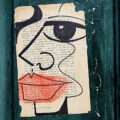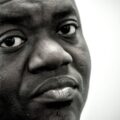The Importance of Being Sad

It was during our usual evening bedtime routine, while my wife read a book to our two-year-old and I was putting our newborn into pajamas, that I saw tears well up in my wife’s eyes. She was reading Shel Silverstein’s book, The Giving Tree, and, reaching the end, had been overwhelmed by emotion. I came over with our newborn in hand and gave her as she herself hugged our two-year-old. All she could say was, “It’s so sad.” I started crying too, and hugged them both even tighter.
The moment passed. We put the girls to bed and started making dinner. But I kept reflecting on her reaction to the book. I mentioned to her an essay I’d read about an artist and writer “fixing” the book’s ending, giving it an alternative title, The Tree Who Set Healthy Boundaries. My wife said she wasn’t sure she felt the book needed to be “fixed.” I agreed with her—but was also curious about what it meant that some people felt like the story needed to be fixed.
I remember Shel Silverstein’s books from my own childhood, which was not a normative one, so that I didn’t encounter them at home during bedtime, but at my elementary school library, not long after immigrating to the United States. I read them on my own, not long after I learned English, and my understanding of the story reflected my own experiences. Having moved to Los Angeles to live with my father after my mother moved in with her new boyfriend, who had mistreated me several times, what I saw in the story was the image of a mother who would do anything for her child—the mother I didn’t have. Yes, I also felt sad for this mother figure, who was left with little of herself, but who had given everything she had for the sake of her child’s happiness. In a sense, it showed me what would have happened to my mother had she given me what I needed, which made me sad. It showed me that this alternative was, in some senses, no happier than my own.
I got older, went to college, and started drawing my own cartoons. I found Shel Silverstein again, this time as a young artist and writer, and saw, in my drawings, echoes of his. I realized that something about his work had resonated so deeply that I was no longer even aware of its influence. It was even reflected in the title of my first cartoon collection: Saddies. There was something about the experience of sadness that I realized was not only central to my own life experience, but also shared by others, who had likely had sad experiences of their own.
I saw something else in the book when I revisited it in young adulthood—my father’s relation to me as a maturing adult. Reading the book after I’d moved out of the house, I suddenly noticed that there was a sort of lag in the way the tree perceived the growing boy. Every time the boy returned, it wanted him to behave the way he’d done when he was younger. His needs had changed, however, and he was somehow always sad to have to explain to the tree that he could no longer behave the way it remembered. It was this gap in the tree’s perception of the boy that led to his explaining to the tree what he needed at that stage in his life. And it was the tree who then, voluntarily, gave the boy some of itself, in order to fulfill his needs. I didn’t have this kind of relationship with my father. But I did feel this moment of frustration as I felt like I was maturing and he was treating me like someone who was just a little younger. And it actually led me to talk to my dad about it and explain myself to him.
The “fixed” version of the story, The Tree Who Set Healthy Boundaries, had an implicit mis-assumption about the boy. He had never actually asked the tree for anything that it had given him. He had only responded honestly to its missed perception of his growth. That he took what the tree offered is a separate issue—and perhaps the “fixed” version should have presented The Boy Who Set Healthy Boundaries and Stopped Taking Everything the Tree Offered. But, as I reflected on these thoughts, I felt like the real issue at hand was the impulse to “fix” literature in the first place.
The writer who’d “fixed” The Giving Tree did hedge against his own phrase in his presentation of his work on his site. “The original works aren’t broken,” he wrote. “They’re beloved by many, and rightfully so. But each one offers up a key moment when the story takes a turn, and in the parodies I explore what would happen if a different choice were made.” Still, this “parody” is motivated by the experience of reading the book, which leaves us sad. Changing social norms aside, they aim to produce endings that avoid this difficult emotion.
Many parents feel this story urges them to give of themselves even when their sacrifices cause irreparable harm—which is why they feel it needs “fixing.” But this may not be a problem with The Giving Tree. It may actually reflect the excesses and shortcomings of our culture. Perhaps, rather than reading it as a guidebook, the book can be read as helping us come into contact with our own anxieties as parents.
Difficult emotions are what literature is all about—including what we read to our kids. Engaging with tales that have captivated readers for years, generations, or centuries involves coming into contact with ideas and worlds that are different from ours and that don’t conform to our own expectations or, sometimes, convictions. Reading is supposed to make us reconsider what we believe. It’s supposed to make us wonder whether we’re following principles that make sense in the long term. It’s supposed to make us confront emotions we’d rather avoid. The book is about sadness—as Shel Silverstein said himself—and if you take that away, you’ve also taken away the book’s unique magic.
So why write a children’s book that’s sad? Because being able to feel sad is a life-skill that’s important. This lesson was embedded, in a slightly more uppity form, in Peter Docter’s animated film, Inside Out, showing that, without sadness, our emotional lives would come crashing down. The Giving Tree‘s lesson for children isn’t bound up in the actions of either the tree or the boy. It’s in the emotions that the children feel when reading what takes place between the two. It’s also in the emotions that the parents feel when reading the book to their children.Each time I read The Giving Tree to my children, I feel painfully sad. Why? Because it brings me in touch with my own desire to give them everything I have—even though I know it would be detrimental both to them and to me. The Tree Who Set Healthy Boundaries may be useful as a self-help book for those who need guidance with this admittedly important parenting skill. But for those who already know the importance of healthy boundaries, The Giving Tree offers access to the boundless love that parents can feel toward their children. And this, as odd as it sounds, makes us feel sad. Because we see that we may never be able to wholly express the full extent of this ubiquitous love.
About David Stromberg
David Stromberg is a writer, translator, and literary scholar. His fiction has appeared in The Woven Tale Press, The Account, and Call me Brackets, his nonfiction in The American Scholar, Los Angeles Review of Books, and Entropy, and his translations in The New Yorker, Conjunctions, and Asymptote. His most recent book is A Short Inquiry into the End of the World (The Massachusetts Review / Working Titles), a novella-length speculative essay, and an edited collection of essays by Isaac Bashevis Singer, Old Truths and New Clichés (Princeton University Press). His followup speculative essay, “The Eternal Hope of the Wandering Jew,” will appear in The Hedgehog Review.





